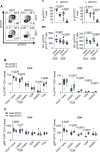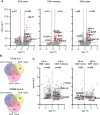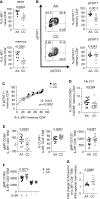IL-6-Driven pSTAT1 Response Is Linked to T Cell Features Implicated in Early Immune Dysregulation
- PMID: 35911690
- PMCID: PMC9327741
- DOI: 10.3389/fimmu.2022.935394
IL-6-Driven pSTAT1 Response Is Linked to T Cell Features Implicated in Early Immune Dysregulation
Abstract
Elevated levels and enhanced sensing of the pro-inflammatory cytokine interleukin-6 (IL-6) are key features of many autoimmune and inflammatory diseases. To better understand how IL-6 signaling may influence human T cell fate, we investigated the relationships between levels of components of the IL-6R complex, pSTAT responses, and transcriptomic and translational changes in CD4+ and CD8+ T cell subsets from healthy individuals after exposure to IL-6. Our findings highlight the striking heterogeneity in mbIL-6R and gp130 expression and IL-6-driven pSTAT1/3 responses across T cell subsets. Increased mbIL-6R expression correlated with enhanced signaling via pSTAT1 with less impact on pSTAT3, most strikingly in CD4+ naïve T cells. Additionally, IL-6 rapidly induced expression of transcription factors and surface receptors expressed by T follicular helper cells and altered expression of markers of apoptosis. Importantly, many of the features associated with the level of mbIL-6R expression on T cells were recapitulated both in the setting of tocilizumab therapy and when comparing donor CD4+ T cells harboring the genetic variant, IL6R Asp358Ala (rs2228145), known to alter mbIL-6R expression on T cells. Collectively, these findings should be taken into account as we consider the role of IL-6 in disease pathogenesis and translating IL-6 biology into effective therapies for T cell-mediated autoimmune disease.
Keywords: STAT1; STAT3; T cells; apoptosis; autoimmunity; interleukin-6 (IL-6); interleukin-6 receptor (IL-6R).
Copyright © 2022 Lambert, Diggins, Jones, Hundhausen, Maerz, Hocking, Sanda, Greenbaum, Linsley, Cerosaletti and Buckner.
Conflict of interest statement
JB is a Scientific Co-Founder and Scientific Advisory Board member of GentiBio, a consultant for Bristol-Myers Squibb and Hotspot Therapeutics, and has past and current research projects sponsored by Amgen, Bristol-Myers Squib, Janssen, Novo Nordisk, and Pfizer. She is a member of the Type 1 Diabetes TrialNet Study Group, a partner of the Allen Institute for Immunology, and a member of the Scientific Advisory Boards for the La Jolla Institute for Allergy and Immunology and BMS Immunology. The remaining authors declare that the research was conducted in the absence of any commercial or financial relationships that could be construed as a potential conflict of interest.
Figures







Similar articles
-
IL-6-driven STAT signalling in circulating CD4+ lymphocytes is a marker for early anticitrullinated peptide antibody-negative rheumatoid arthritis.Ann Rheum Dis. 2016 Feb;75(2):466-73. doi: 10.1136/annrheumdis-2014-205850. Epub 2015 Feb 3. Ann Rheum Dis. 2016. PMID: 25649145 Free PMC article.
-
Enhanced T cell responses to IL-6 in type 1 diabetes are associated with early clinical disease and increased IL-6 receptor expression.Sci Transl Med. 2016 Sep 14;8(356):356ra119. doi: 10.1126/scitranslmed.aad9943. Sci Transl Med. 2016. PMID: 27629486 Free PMC article.
-
IL-27 mediates HLA class I up-regulation, which can be inhibited by the IL-6 pathway, in HLA-deficient Small Cell Lung Cancer cells.J Exp Clin Cancer Res. 2017 Oct 11;36(1):140. doi: 10.1186/s13046-017-0608-z. J Exp Clin Cancer Res. 2017. PMID: 29020964 Free PMC article.
-
Interleukin-6: A Masterplayer in the Cytokine Network.Oncology. 2020;98(3):131-137. doi: 10.1159/000505099. Epub 2020 Jan 20. Oncology. 2020. PMID: 31958792 Review.
-
Blocking only the bad side of IL-6 in inflammation and cancer.Cytokine. 2021 Dec;148:155690. doi: 10.1016/j.cyto.2021.155690. Epub 2021 Aug 30. Cytokine. 2021. PMID: 34474215 Review.
References
Publication types
MeSH terms
Substances
Grants and funding
LinkOut - more resources
Full Text Sources
Molecular Biology Databases
Research Materials
Miscellaneous

